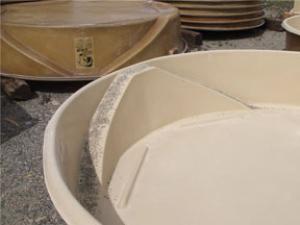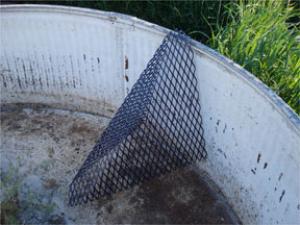Sage-Grouse: Livestock Water Tanks
Watering tanks installed for livestock are often used by a diversity of wildlife as well. These tanks benefit livestock, big game, and other wildlife but can have unintentional negative consequences for some species if they are not designed properly.
Built-in ramps are available
in many new tanks.

A ramp insert to retrofit an
older water tank.

Sage-grouse are one species known to accidentally drown in livestock water tanks that do not have adequate escape opportunities. Considering the needs of wildlife in the installation of livestock water tanks is not only the right thing to do, it results in cleaner water for livestock and less maintenance for the operator.
To provide effective escape opportunity, a ramp should be placed so animals swimming the edges of the tank can come in contact with the ramp. If the ramp does not extend to the edges of the tank, wildlife often swim under the ramp and ultimately perish. One drowning example occurred in Musselshell County, Montana, where 17 birds drowned in the same tank. A Montana Fish, Wildlife and Parks memo states, “Following the discovery of the first nine birds in the tank, a plank covered with chicken wire was placed in the water to make it possible for the birds to escape from the tank. Unfortunately, the plank did not prevent additional mortalities (because the birds swam under the ramp) and eight additional birds drowned.”
To address this problem, the Natural Resources Conservation Service (NRCS) offers both technical and financial assistance to landowners to develop escape opportunities in existing tanks or design them into new tank installations. Both expanded metal and fiberglass options currently exist to retro-fit existing tanks, and some companies now offer built-in ramps in new tanks. These escape ramps have been extensively tested and monitored with exceptional results and are available at a very low cost.
Please see your local NRCS office for more information about making your livestock water facilities safe for wildlife.

